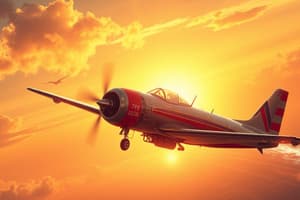Podcast
Questions and Answers
What type of maintenance involves tasks such as checking oil levels, tire pressures, fuel quantity, lights, brakes, and instruments?
What type of maintenance involves tasks such as checking oil levels, tire pressures, fuel quantity, lights, brakes, and instruments?
- Base maintenance
- Line maintenance (correct)
- Troubleshooting
- Corrective maintenance
What is the purpose of line maintenance?
What is the purpose of line maintenance?
- To inspect the structural integrity of an aircraft
- To perform major repairs or replacements of parts
- To modify the configuration of an aircraft
- To ensure the aircraft is airworthy before each flight (correct)
What type of tasks are typically performed during line maintenance?
What type of tasks are typically performed during line maintenance?
- Testing the systems
- Inspecting the structural integrity
- Minor repairs or replacements of accessible parts (correct)
- Overhauling the engines
What is the primary focus of line maintenance?
What is the primary focus of line maintenance?
What is the typical frequency of line maintenance?
What is the typical frequency of line maintenance?
What is not typically performed during line maintenance?
What is not typically performed during line maintenance?
What is the primary purpose of line maintenance?
What is the primary purpose of line maintenance?
What type of maintenance is typically performed at a main base facility?
What type of maintenance is typically performed at a main base facility?
What is included in line maintenance tasks?
What is included in line maintenance tasks?
Which category of maintenance organization approval includes maintenance on aircraft and components when fitted to the aircraft?
Which category of maintenance organization approval includes maintenance on aircraft and components when fitted to the aircraft?
Where is line maintenance typically performed?
Where is line maintenance typically performed?
What is the main difference between line and base maintenance?
What is the main difference between line and base maintenance?
What is ensured during a physical survey of the aircraft?
What is ensured during a physical survey of the aircraft?
What is the maximum period by which an airworthiness review can be anticipated?
What is the maximum period by which an airworthiness review can be anticipated?
What is necessary for an Airworthiness Review Certificate to be issued?
What is necessary for an Airworthiness Review Certificate to be issued?
What is an important aspect of the aircraft maintenance programme (AMP)?
What is an important aspect of the aircraft maintenance programme (AMP)?
What is ensured during the continuing airworthiness management process?
What is ensured during the continuing airworthiness management process?
What is the purpose of the physical survey of the aircraft?
What is the purpose of the physical survey of the aircraft?
Flashcards
Line Maintenance
Line Maintenance
Preventive maintenance tasks performed on an aircraft before, between, or after flights.
Purpose of Line Maintenance
Purpose of Line Maintenance
To ensure the aircraft is airworthy for each flight.
Line Maintenance Tasks
Line Maintenance Tasks
Minor repairs and replacements of accessible parts.
Line vs. Base Maintenance
Line vs. Base Maintenance
Signup and view all the flashcards
Frequency of Line Maintenance
Frequency of Line Maintenance
Signup and view all the flashcards
Base Maintenance
Base Maintenance
Signup and view all the flashcards
Physical Survey
Physical Survey
Signup and view all the flashcards
Airworthiness Review
Airworthiness Review
Signup and view all the flashcards
Airworthiness Review Certificate
Airworthiness Review Certificate
Signup and view all the flashcards
Aircraft Maintenance Program (AMP)
Aircraft Maintenance Program (AMP)
Signup and view all the flashcards
Continuing Airworthiness Management
Continuing Airworthiness Management
Signup and view all the flashcards
Category A Approval
Category A Approval
Signup and view all the flashcards
Line Maintenance Tasks - Specific Actions
Line Maintenance Tasks - Specific Actions
Signup and view all the flashcards
Aircraft Airworthy
Aircraft Airworthy
Signup and view all the flashcards
Exclusion from Line Maintenance
Exclusion from Line Maintenance
Signup and view all the flashcards
Physical Aircraft Survey Purpose
Physical Aircraft Survey Purpose
Signup and view all the flashcards
Study Notes
Maintenance Records
- Copies of each ARC issued, recommended, or extended, along with supporting documents, must be retained for up to 24 months after the aircraft is permanently withdrawn from service.
- Records must be protected from damage, theft, and alteration, with computer back-ups stored in a different location.
Line and Base Maintenance
- Line maintenance: routine and preventive maintenance performed on an aircraft before, between, or after flights, including tasks such as checking oil levels, tire pressures, and fuel quantity.
- Base maintenance: periodic and corrective maintenance performed on an aircraft at longer intervals, including tasks such as inspecting structural integrity, testing systems, and overhauling engines.
Troubleshooting
- Troubleshooting: the process of identifying the cause of a malfunction, determining its severity, eliminating the cause, and replacing or repairing discrepant components, systems, or structures.
EASA Part 66 and 145
- EASA Part 66: maintenance certifying staff
- EASA Part 145: maintenance organization approval, including a class and rating system for maintenance categories
Class and Rating System
- Category A: maintenance on aircraft and components when fitted to the aircraft, including "line" maintenance before flight to ensure aircraft fitness.
- Category B: "off-wing" or uninstalled engine and APU maintenance and overhaul.
Airworthiness Review
- The physical survey of the aircraft ensures:
- All required markings and placards are properly installed
- The aircraft complies with its approved flight manual
- The aircraft configuration complies with approved documentation
- No evident defects are found that have not been appropriately addressed
- The airworthiness review can be anticipated by a maximum of 90 days without loss of continuity.
- An Airworthiness Review Certificate can be issued when the airworthiness review is properly carried out and the aircraft is airworthy.
Studying That Suits You
Use AI to generate personalized quizzes and flashcards to suit your learning preferences.
Description
Test your knowledge of EASA Part 66 regulations, including record-keeping requirements, maintenance procedures, and staff responsibilities. This quiz covers essential topics for maintenance certifying staff and line maintenance.



